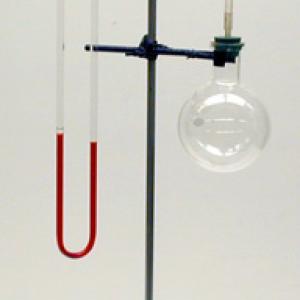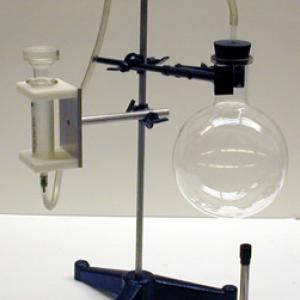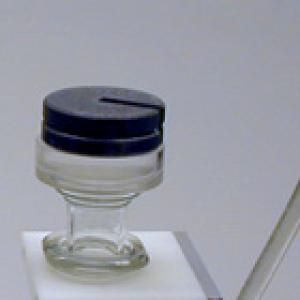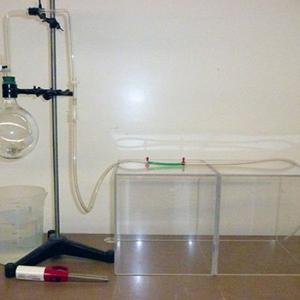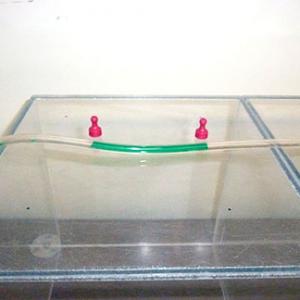College of Liberal Arts & Sciences
4E10.10 - Charles' Law and Gas Pressure Doing Work - Glass Piston
Video Credit: Jonathan M. Sullivan-Wood.
Use your hands to warm the bulb. The grill lighter may be used if a higher temperature is desired. When warmed the liquid in the manometer should move quite dramatically. The ice bath can be used to make the liquid move in the opposite direction.
Since the liquid level rises only a few cm maximum the entire system is essentially at a constant pressure.
Assemble the unit as shown. Place the Bunsen burner under the flask and in about 30 seconds the plunger will start to move. Place 100 grams of weight on the plunger and in a few more seconds it will again rise with the additional weight.
IMPORTANT NOTES: As soon as the plunger starts to rise with the additional weight remove the flame, and either add additional weights before the plunger reaches the top of its stroke or be sure to catch it as it pops our under pressure.
BE sure that at no time, under any conditions, can the plunger fall out and break!!!!!!
This syringe will need very light lubrication at most.
- Krzysztof Rebilas, "A Microscopic Perspective on the Work Done by an Ideal Gas", TPT, Vol. 61, #8, Nov. 2023, p. 699.
- Gavin D. Peckham, "P-V Diagrams Have More to Offer", TPT, Vol. 35, # 1, p. 56, Jan. 1997.
- Volker Thomsen, "Solution of Third-Order Polynomials", TPT, Vol. 32, # 1, Jan. 1994, p. 24.
- Robert W. Bird, "Got an Equation to Solve?", TPT, Vol. 32, # 4, Apr. 1994, p. 199.
- N. Gautheir, "More Help for Thomsen", TPT, Vol. 32, # 4, Apr. 1994, p. 200.
- Huang Guo-xiong, "Thermodynamic Transport of Eggs", TPT, Vol. 31, # 2, Feb. 1993, p. 119.
- Michael D. Edmiston, "Boiling, Bubbles, and Pressure", TPT, Vol. 27, # 3, Mar. 1989, p. 136.
- Thomas O, Callaway and Harry D. Downing, "Response", TPT, Vol. 27, # 3, Mar. 1989, p. 136.
- Clayton, Callaway, and Downing, "Experiments with Disposable Hypodermic Syringes", TPT, Vol. 26, # 1, p. 19, Jan. 1988.
- V. V. Raman, "Where Credit is Due - The Gas Laws", TPT, Vol. 11, # 7, p. 419, Oct. 1973.
- David P. Jackson and Priscilla W. Laws, "Syringe Thermodynamics: The Many Uses of a Glass Syringe", AJP, Vol. 74, # 2, Feb. 2006.
- Martin Gardner, "Dancing Dime", Entertaining Science Experiments with Everyday Objects, p. 102.
- Overbeck et al., "Boyle's and Charles' Laws", Selective Experiments in Physics, Central Scientific Company, 1940.
- Overbeck et al., "Charles' Law", Selective Experiments in Physics, Central Scientific Company, 1959.
- Overbeck et al., "Expansion of Gases", Selective Experiments in Physics, Central Scientific Company, 1940.
- V. E. Eaton et al., "Charles' Law", Selective Experiments in Physics, Central Scientific Company, 1940.
- Curt Suplee, "Pressure and gases", Everyday Science Explained, National Geographic, p. 44.
Disclaimer: These demonstrations are provided only for illustrative use by persons affiliated with The University of Iowa and only under the direction of a trained instructor or physicist. The University of Iowa is not responsible for demonstrations performed by those using their own equipment or who choose to use this reference material for their own purpose. The demonstrations included here are within the public domain and can be found in materials contained in libraries, bookstores, and through electronic sources. Performing all or any portion of any of these demonstrations, with or without revisions not depicted here entails inherent risks. These risks include, without limitation, bodily injury (and possibly death), including risks to health that may be temporary or permanent and that may exacerbate a pre-existing medical condition; and property loss or damage. Anyone performing any part of these demonstrations, even with revisions, knowingly and voluntarily assumes all risks associated with them.
